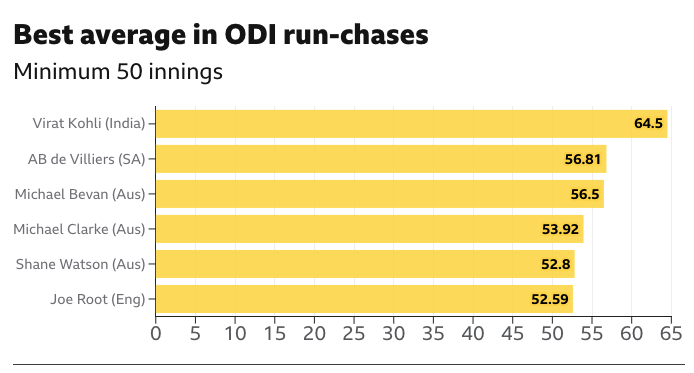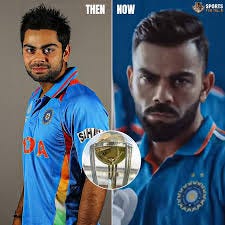India recently won the Champions Trophy, and by “won,” I mean they absolutely dominated the tournament, sweeping up victories after victories. Meanwhile, a few days before the finals, Australian cricketer Steve Smith decided to retire from international cricket’s 50-over format. In front of a crowd of reporters, Smith bid adieu to the sport. But before he left, he dropped a gem of a compliment about Virat Kohli, saying, “Virat is arguably the best chaser the game has seen. He has done it numerous times against us. He controls the tempo of the game really well.”
As a longtime Virat Kohli fangirl, this comment made my heart do a little happy dance. But it also got me thinking: what exactly makes someone a great chaser in cricket? Is it sheer competitiveness? Is it the ability to stay calm under pressure, like a cucumber in a fridge during a heatwave? Turns out, the secret sauce to Kohli’s chasing success isn’t just his cricketing skills or his zen monk attitude — it’s his fitness. The man himself said, “Fitness for me is probably more important than cricket practice. A fit body makes you think better.” In other words, running laps and lifting weights is the real brahmastra, not his ability to hit sixes while looking effortlessly stylish.
Every week on The Lighter Side, I pick a news story and overthink it until it becomes a life lesson. This week’s story is inspired by Steve Smith’s glowing tribute to Virat Kohli. I decided to dive deep into the mind of a world-class batsman to understand how his physical fitness shapes his game. Spoiler alert: I found some golden nuggets of wisdom that apply not just to cricket, but also to my chaotic life of running a company, parenting two teenagers, and trying to remember where I left my car keys.
I had a blast researching it, mostly because it gave me an excuse to watch cricket highlights and call it “work.” If you learn something about life, great. If not, at least you’ll know why Virat Kohli is the Usain Bolt of cricket chasers.
Quick look at the cricketing stats
He has the highest average in ODIs while chasing, a good distance from the next five.
In his own words, "Chasing is all about pressure, especially big games like semis and finals and if you go deep enough into the innings, and you have enough wickets in hand, the opposition usually gives in and then the game becomes easier”.
Virat Kohli isn’t the cool cucumber that Dhoni is. He does have his share of temper flare-ups, but you don’t see any of that affecting his judgement while chasing big targets. What he does really well is to take the pressure on his shoulders and keep the scoreboard ticking. The opposition begins to slowly give up and tune out of the match (almost like they suddenly remember they left the oven on at home and realise they can’t do much about it standing where they are). His chasing strategy is simple - combine patience, precision, and psychological warfare.
How does he handle pressure so well?
He does not spend hours meditating, neither does he have any special yoga techniques that help him not get stressed while he is on the field. Instead, he just focuses on rotating the strike. He’s the king of ones and twos and the sultan of sneaky gaps. He’s scored more singles in ODI history than anyone else.
The reason he is able to stay calm is because he is steadily piling up runs with singles instead of panicking at the last minute when you need 20 runs an over. His golden rule is to keep the scoreboard moving, even if it’s just one run at a time. Boundaries are great, but they’re like dessert—nice to have, but you can’t survive on them alone.
Centuries in Chases
Kohli has scored 28 centuries while chasing. This is a world record in ODI history.
The second highest is quite some way off at 17. This record is held by Sachin Tendulkar.
Here lies the million-dollar question: if Virat Kohli’s chasing strategy is so simple, why doesn’t everyone just copy it and become a run-chasing demigod? I mean, it’s not like he’s out there with a special superpower solving world hunger—he’s just running between the wickets like a man who’s late for a very important meeting. It’s the cricketing equivalent of studying a little bit every day instead of cramming the night before an exam. It’s not rocket science that his strategy is an elegant recipe for success; it’s common sense (coupled with a side of world-class talent).
So, what’s the difference between Kohli and other batsmen? His secret is discipline, focus, and a willingness to do the boring stuff better than anyone else. That boring stuff is driven largely by his physical fitness.
Why physical fitness is key to his being a good chaser
Hitting a few singles might sound easy until you realize that running back and forth across a 20-yard pitch 50 times is a cardio workout disguised as a cricket match. Perhaps that is why most batsmen rely on a mix of skill and luck to score runs. They wait for the bowler to slip up, toss them a juicy easy ball, and then whack it to the boundary like they’ve just won the lottery. But Kohli? He doesn’t have time for luck. He’s too busy finding gaps in the field like he’s got a built-in GPS for empty spaces.
Endurance is not just about being able to run constantly. It is also about keeping your brain from turning into mush. When you’re physically exhausted, your decision-making skills go out the window. But for Kohli, even though he’s out there running like a marathoner, he is still able to think strategy and tactics like a chess grandmaster. Because he is so fit, he remains mentally alert for longer than most other batsmen and manages to make his chases look like he’s on a casual jog in the park. Whereas, less fit batsmen are gasping for air, losing focus, and making mistakes that lead to their inevitable dismissal.
Physical endurance plays a large role in staying mentally calm for longer than most others. That is why when Kohli calmly turns singles into doubles, doubles into boundaries, and boundaries into victory, it’s not just about scoring runs; it’s about outlasting the opposition—both physically and mentally.
Kohli’s workout plan, his diet regimen and sleep/rest schedules are publicly available for anyone to know (and I have pasted them right below, for your reference). Yet, there are few cricketeers who emulate him, because following these routines day after day, year after year, without a single day’s break requires a level of discipline, that few others possess. In that may lie the answer to why he is such a good chaser.
As I was researching for this piece and digging into his psyche, I felt inspired to set myself a challenge for 60-days. I am going to take parts of his diet and exercise regimen that can work for me, and I am going to follow it without a break for 60 days (no cheat days in my diet - eat healthily - workout 5 days a week and sleep at 9:30pm). Would you like to try this experiment along with me, maybe for a shorter duration of 7 days? Pasted below are his diet and exercise details. My aim is to see if I have the discipline it takes to do something like this consistently. I also want to see how much this diet and exercise improves my ability to focus, think more clearly and stay calm under moments of pressure. If you are going to give it a try, I’d love to hear from you how you felt at the end of 7 days. Do write to me at hello@wsnt.in and share your thoughts.
Virat Kohli’s diet pattern
Breakfast - Freshly made smoothies with zero sweeteners, freshly cut fruits, nuts (e.g. almonds, walnuts, and cashews)
Lunch and Dinner - Brown bread, spinach, grilled vegetables and a protein shake on the side. He eats a variety of grains and millets (but avoids those with gluten given his medical constraints).
"90% of my food is steamed or boiled. There is no masala. I consume only salt, pepper, and lime. Salads are delicious with a little dressing. I only eat dal (lentils), not masala curries. I do, however, eat rajma and lobhiya; as a Punjabi, I can't avoid them. Even these are made with no masala. I never touch any food that is fried."
Snacks: Seeds, almonds, fruits, smoothies, sprouts, and salads. No processed foods and sugary snacks. Two cups of coffee daily, no sugar.
Foods he NEVER eats - Fried foods, curries, highly spiced dishes, sweets in any form.
Hydration is very important for him. He is meticulous about not only his eating but also his water.
Virat Kohli’s exercise regimen - 5 days a week
Warm-up session includes 5-10 minutes of light cardio, such as jogging or jumping jacks, 5-10 minutes of dynamic stretches, such as arm circles and leg swings
Cardio exercises - Running, swimming, biking
Compound exercises - any set of exercises that works together for multiple muscle groups at the same time is called a compound exercise. If you lift a heavy school bag and walk a km, that is a compound exercise. Kohli does exercises like squats, deadlifts, bench presses, and overhead presses.
Cool-down - 5-10 minutes of light cardio, 5-10 minutes of static stretches, such as holding a hamstring stretch or a calf stretch.
If you notice, his diet consists solely of healthy foods and eliminates all that is unhealthy. There is no groundbreaking science in identifying that processed foods like biscuits, cookies, Maggi noodles, and potato chips are unhealthy. There is no new discovery in recognizing that fried foods are detrimental to both the mind and body. Nor is there any new revelation in understanding that sugary foods often dull not just our bodies but also our minds. The difference between Virat Kohli and others lies simply in the fact that he adheres to this regimen without any breaks. There are no cheat days in his diet. He goes to bed by 9:30 PM every single day and works out at the gym five days a week—every week, all year round. Consistency is the key, not just moments of brilliance.
Kohli’s backstory
2008 was the year Virat Kohli went from being a wide-eyed teenager to a suddenly famous cricketer who discovered the joys of fame, parties, and, apparently, not caring about fitness. Back then, he was less “run-machine” and more “fun-machine,” living the dream of hanging out with the cool kids, eating whatever he wanted, and treating training like an optional extra. Despite his party-hard lifestyle, he was still the darling of the selectors, playing for India and the IPL, because talent has a funny way of keeping you afloat even when you’re busy sinking.
But then came 2012, the year Kohli had a reality check. After some great tours and a sparkling 180 against Bangladesh, he strutted into the IPL thinking, “This is going to be my season. Bowlers, prepare to be dominated.” Spoiler alert: it wasn’t. His training was a disaster and his diet was a dumpster fire. By the end of the IPL season in 2012, he was so relieved it was over that he probably considered retiring. But then, one fateful day, he stepped out of the shower, caught a glimpse of himself in the mirror, and had an epiphany: “You can’t look like this if you want to be a professional cricketer.”
From that day on, he hit the gym without fail, cut out gluten, wheat, cold drinks, and desserts, and basically turned his life into a never-ending episode of Extreme Makeover: Cricket Edition. He also embraced a vegetarian diet due to medical considerations. For the first two months, he claimed he was so hungry he considered eating his bedsheet.
And then, the results started rolling in. He felt quicker, more energetic, and less like a human burrito. By 2015, he levelled up further, adding weightlifting to his routine. Who knew lifting heavy things could make you feel like a superhero!
Kohli’s fitness obsession has inspired the entire Indian team to be the fittest squad in cricket history. For Kohli, this isn’t just about cricket; it’s about building a legacy! And honestly, if anyone can make it happen, it’s the guy who once craved his bed-sheet for dinner.
Our new writing course for kids
Ever wondered how to turn a child’s wild, wacky, and what-on-earth-is-this ideas into actual stories? Our writing course for kids is here to save the day. This isn’t your average group class chaos—it’s 1-on-1, so our little Shakespeares can go at their own pace (no rushing, no pressure). Built on the Cambridge Curriculum’s golden rules of writing, each session kicks off with fun games and ends with a writing prompt that’ll spark their creativity. By the end, they’ll have 8-12 short stories ready to impress.
✅ A 12-session journey where kids learn the framework of writing
✅ They will write 8 short stories and refine their craft along the way.
✅ At the end, parents can choose to publish their child's very own book!
Course Details
✔️ One-on-one sessions—pick a date & time that suits your child. This can change from week to week, per your convenience.
✔️ INR 600/- per session
✔️ Enrol now by paying for the first 4 sessions.
✔️ Once you enrol, you'll get access to the scheduling link to book your child’s sessions.
Podcast to listen
Books make excellent gifts, particularly for young readers seeking new stories and characters that transport them to imaginative worlds. In a recent podcast episode, ten young readers joined me to share their favorite books from 2024. These recommendations, perfect for children aged 8 to 15, span a wide range of genres—adventure, mythology, history, self-help, and fantasy. Where better to get book suggestions than straight from the source? The episode is now available on Spotify and Apple Podcasts. You can also listen to it by clicking the link below. Happy listening—and reading!
References
Virat Kohli’s intense workout regimen
Yuvraj Singh, speaking about how there was no fitness focus earlier in cricket
Virat is the game’s best chaser, a news report
Career stats: Virat Kohli, source ESPN







